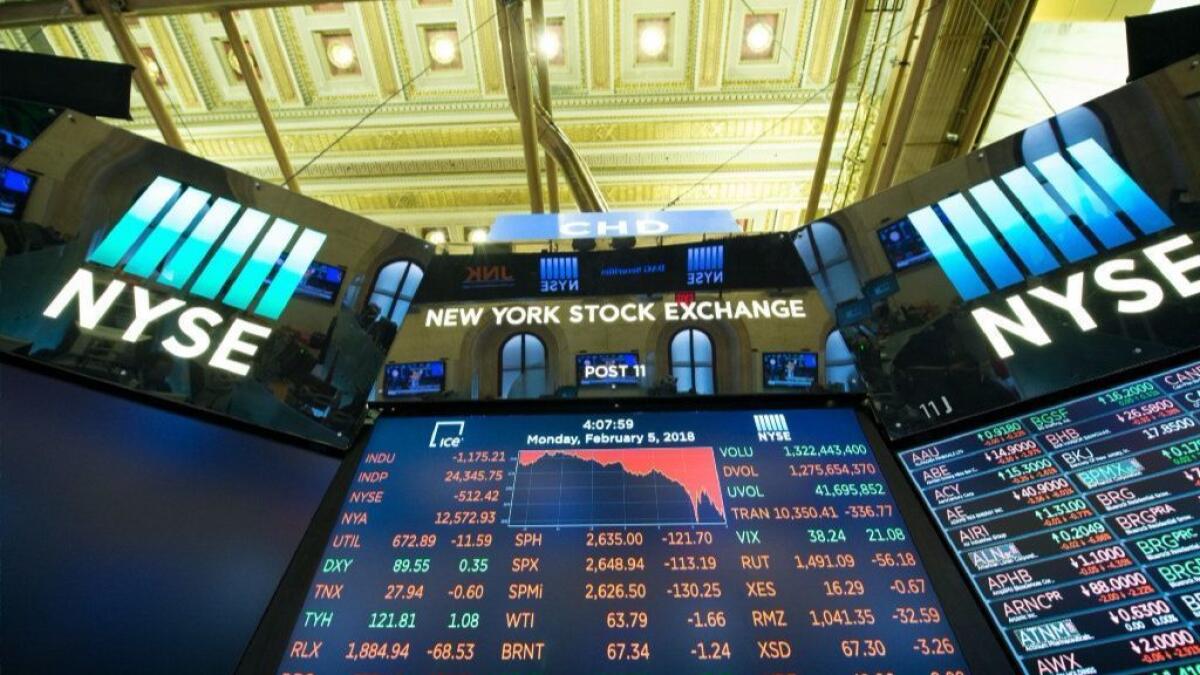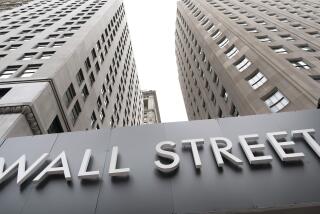Why the stock market’s tranquil ascent abruptly turned into a roller-coaster ride

- Share via
Financial advisor Todd Morgan has plenty of rich clients in Southern California who needed to hear a soothing word about the stock market’s wild gyrations last week.
“This calls to mind my favorite saying, ‘The market will do whatever it has to do to prove the most people wrong,’” said Morgan, chairman of Bel Air Investment Advisors in Century City, which caters to high-worth customers.
His point: Until this month, many investors had grown accustomed over the prior year to nearly optimum conditions in the stock market. Shares kept climbing to record levels, propelled by growing economies and corporate earnings worldwide, low inflation, subdued interest rates and, perhaps most important, relative calm in trading each day.
The calm abruptly ended last week when the market tanked — with the Dow Jones industrial average plunging a record 1,175 points on Monday, after a 666-point drop the prior Friday — and then swung sharply up and down the rest of the week.
After the Dow plummeted an additional 1,033 points Thursday, the average of 30 blue-chip stocks had officially endured what’s known as a “correction,” or a loss of 10% from its most recent high, which was Jan. 26 when the Dow hit a record peak of 26,616.71.
Technically the correction lasted all of one day, as the Dow capped its wild week with a 330.44-point gain Friday to finish at 24,190.90. But the Dow still lost 5.2% for the week, its worst weekly decline in two years, to leave it 9.1% below its record high.
The broader Standard & Poor’s 500 index, widely viewed as the market’s main gauge, and the technology-heavy Nasdaq composite index were down 8.8% and 8.4%, respectively, since they also reached all-time highs Jan. 26.
Volatility and a sharp reversal in prices suddenly were back on Wall Street and on foreign markets, all in response to reignited fears among investors that U.S. inflation and interest rates are going up.
So what was the market telling us?
Primarily that investors finally decided that stock prices had risen too far too fast even though corporate earnings, one of the main drivers of share prices, also have been rising. Also, that years of exceptionally low interest rates might be coming to an end.
After all, the Dow had surged 25.1% last year and then jumped an additional 5.8% in January alone. Even after last week’s drop, the Dow is still up 32% since President Trump was elected Nov. 8, 2016, and the S&P 500 is up 22%.
The losses last week might have seemed scary to the casual observer, and market watchers and the financial media trotted out investment strategies for “surviving” the market’s pullback. But the downturn was not unusual in response to how much prices had rallied, analysts said.
“Market psychology was bordering on euphoria in late January and is coming back down to earth now,” investment strategist Paul Eitelman of Russell Investments said in a blog post.
In addition, the market reminded investors who had been lulled into complacency that it’s not unusual for prices to swing widely on occasion.
“This is an important reminder to investors that 2018 is not 2017 when it comes to the stock market,” analysts at the investment firm Robert W. Baird & Co. said in a note to clients.
Indeed, some of the biggest losses last week were suffered by investors who had poured money into exchange-traded products, which track sections of the market and are essentially a bet on continued low volatility.
But the market on average has abruptly pulled back between 5% and 10% at least once a year going back to World War II, so the latest decline “would be completely normal,” said Steve Nielander, a finance lecturer at San Diego State University and a partner at the wealth management firm HPM Partners in Costa Mesa.
“We went over 400 trading days without a 5% pullback” before last week’s turmoil, Nielander said. “There really had been no volatility in the market.”
Before last week, the market last had abruptly fallen in mid-June 2016 after the surprise vote by Britain to leave the European Union, a two-day sell-off that knocked 4.8% off the Dow. But then the market quickly roared back to erase those losses.
This time, investors — knowing they were sitting on very healthy profits from the market’s run-up — wasted no time in selling to cash in some of those profits, and a herd effect took over on the days when prices fell precipitously.
The return of volatility has been especially pronounced among the highflying tech stocks such as Apple Inc., Google parent Alphabet Inc. and Amazon.com, because so much of the valuations of tech companies rest on their prospects rather than prior results. Any disruption to their growth forecasts can rattle investors.
“Most of their value is based on what they will become in the future,” said Lawrence Harris, a finance professor at USC’s Marshall School of Business.
The market’s latest sell-off was sparked by a strong U.S. jobs report Feb. 2 that included news that workers’ average wages went up in January. Wall Street instantly interpreted the reports as evidence that the economy is heating up.
That would seem to bode well for businesses and consumers. But for the stock market, it also carried the prospect that interest rates and inflation will rise as a result, which can hurt share prices.
Last week’s roller coaster ride was the latest illustration of how, while the stock market can sometimes be a leading indicator of the economy, it is not the economy. The market mainly reflects investors’ collective perception about where the economy and corporate profits are headed.
“Nothing is wrong economically,” Greg McBride, chief financial analyst at Bankrate.com, said in an email. “The economy is doing better now than it has at any time in the past decade.”
“This is just some healthy, and overdue, volatility to wring out any excess” in the market, he said.
Still, the yield on the 10-year Treasury note has climbed to a four-year high of about 2.84%, and the Federal Reserve — now under a new board chairman, Jerome Powell — has said the central bank plans three more small increases in its benchmark short-term interest rate, currently at 1.25% to 1.5%.
Some analysts fear the Fed might raise rates more often than that as the economy picks up steam. Investors will watch closely on Wednesday, when the latest reading of the consumer price index is released.
But William Dudley, president of the Federal Reserve Bank of New York, told Bloomberg TV last week that the Fed’s current plan “still seems like a very reasonable projection.”
The question of whether higher rates actually could brake the economy’s growth “to me is the X factor in all of this,” said Eric Schiffer, chief executive of the Patriarch Organization, a private equity firm in Santa Ana.
The economy’s fundamentals “are strong and will be getting stronger,” especially as the recently enacted tax plan fully takes hold, Schiffer said. The tax overhaul includes cutting the federal corporate tax rate to 21% from 35% and lowering personal rates.
But higher costs for credit “could be a byproduct of that success,” he said.
Regardless, some see the market’s pullback as a perfect buying opportunity, especially in sectors such as technology, financials, retail, energy and aerospace and defense, which also is expected to benefit from the Trump administration’s push for higher military spending.
Before last week’s declines, the price-to-earnings ratio of the S&P 500 for the next 12 months was running about 18 to 20, well above the historical average of 15.5 and a signal that prices were getting rich. But after the declines, that ratio dropped back to 16.3 on Friday, according to FactSet Research Systems Inc.
That’s one reason why Bel Air’s Morgan said he’s been generally advising his clients to stay the course and why he’s been buying more stocks.
Prices have plummeted mainly because “we were due for a correction,” Morgan said. Now that it’s happened, he added, “we’re putting a lot of money to work. I think the market is going to end the year much better.”
Times staff writer Tracey Lien contributed to this report.
Twitter: @PeltzLATimes
More to Read
Inside the business of entertainment
The Wide Shot brings you news, analysis and insights on everything from streaming wars to production — and what it all means for the future.
You may occasionally receive promotional content from the Los Angeles Times.











